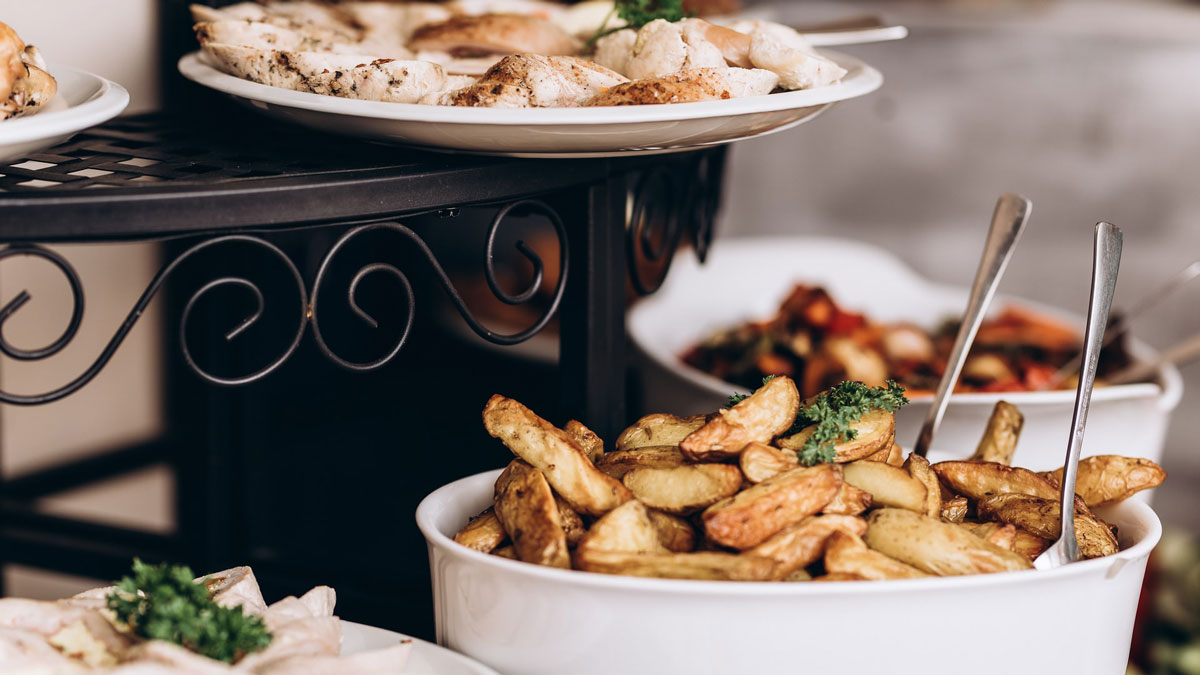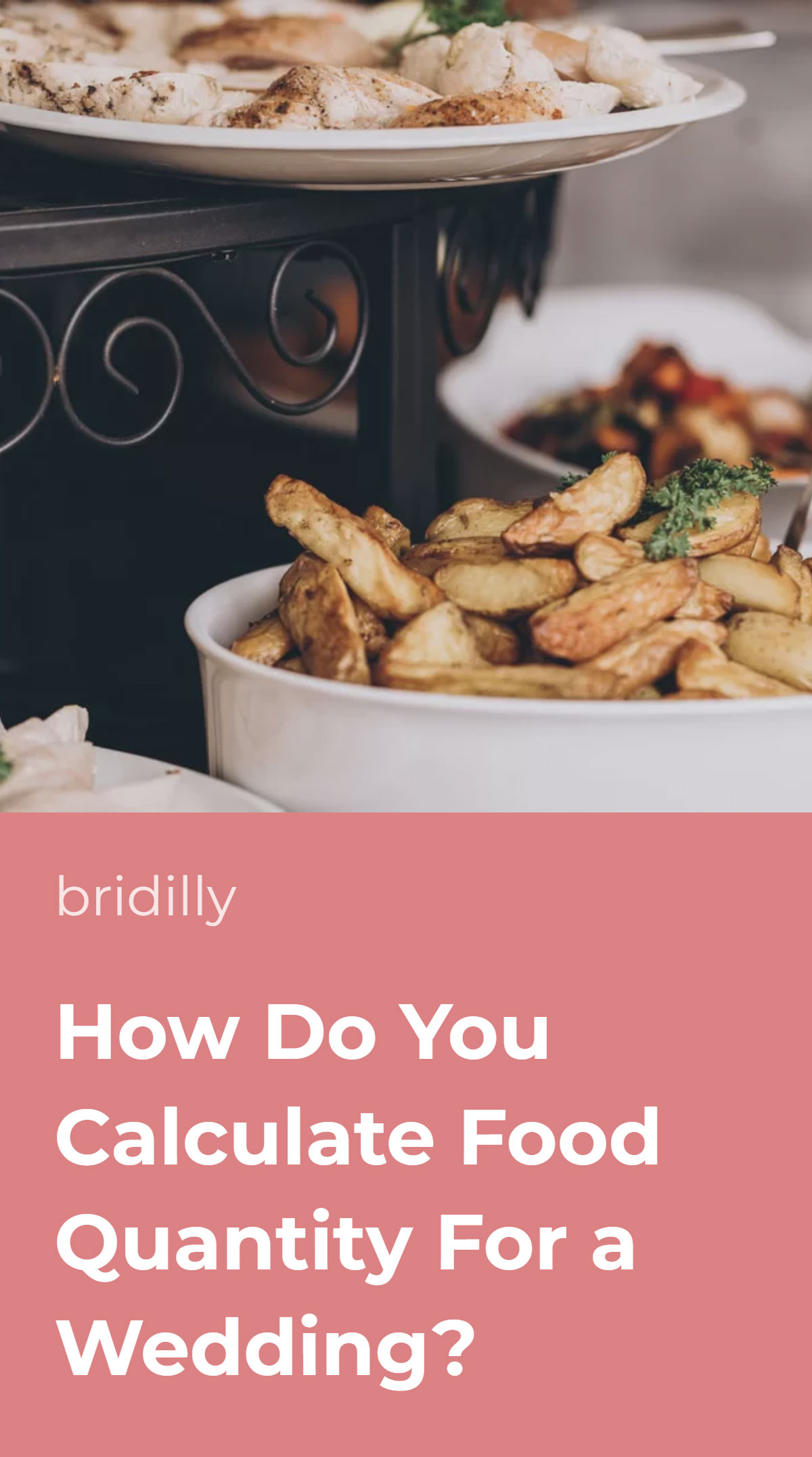Wedding planning isn’t all fun and games. At some point, you will have to calculate the necessary wedding food quantity.
That’s a tricky task, especially if you’ve opted for a DIY wedding reception and don’t have an experienced caterer or wedding planner to help you.
You want to keep your guests full and cheerful, not hangry and bored. However, you should also stay mindful of your budget.
Serving a multiple-entrée meal for the entire bridal party isn’t cheap, and the more guests you expect, the more critical correct calculation is.
If you’re going to estimate the necessary food amount yourself, be prepared – you will need a lot of time and a calculator.
Table of Contents [show]
Planning Considerations
You should consider multiple points before you start calculating how much food to serve at your wedding reception. The serving sizes may differ depending on whether you’ll have a plated or buffet-style reception.
Estimating the necessary food amount for a plated reception is much easier, as you’re in complete control of the portions.
Furthermore, many couples ask guests to mention their meal selection in the RSVP, which is of great help in planning.
While buffet-style receptions are overall cheaper, there’s always a risk of ordering too much food.
As guests serve the food themselves, couples want to ensure everyone gets the meal they want and tend to get more food than required.
On the other hand, if you stick with the recommended average portion sizes, some guests may not get to their desired dish on time. The issue here is that you can’t know which meals will be the most popular in advance.
If your budget is tight and you want to estimate the necessary food amount for your buffet reception as closely as possible, consider hiring a staffer who will serve food from the buffet line to keep the portions consistent.
Family-style entrees are a combination of plated and buffet receptions. Meals are served on large platters that are passed on around the table, and guests serve food themselves.
Remember that some of your guests may be more generous serving their meal than others. Therefore, account for bigger portions than you would with a plated reception.
Another point to consider is guest allergies and dietary restrictions. Some of your guests may be vegetarians or have allergies to common ingredients, and you should accommodate everyone.
Keeping in mind dietary restrictions is necessary for two reasons.
Firstly, you don’t want your guests to stay hungry or get into the hospital with a severe allergic reaction. Secondly, you don’t want to spend money on food that will end up in the trash.
Appetizers
Most couples opt for various bites as appetizers, be it passed hors d’oeuvres or self-service buffet snacks. Account for 2-5 single appetizer portions per guest, depending on how filling it is.
Suppose you’re planning to serve mini-sized beef sliders, spring rolls, and biscuits with cheese.
If you serve three portions of each appetizer for 50 guests, you will need to make 150 portions of each appetizer or 450 portions in total.
Some appetizers require dip – estimate about 1 pint per 10 guests. The necessary appetizer portion number also depends on how long your guests will be waiting for the main entrée.
If the intermission between the ceremony and reception is long, offer more snacks to keep your guests in a good mood. Multiply the necessary number of bites per cocktail party duration in hours.
So, if you have 50 guests, three appetizer types, and the cocktail party lasts for three hours, you will need 1350 appetizer portions.
If you’re planning to party all night long, offer your guests late snacks. They may be the same as appetizers, but you should account for extra hours of fun and prepare more portions.
Meat & Fish Dishes
Calculating the necessary meat or fish amount for main entrees is relatively straightforward. Estimate 6-8 ounces of meat or fish per guest.
However, if you’re serving two meat or fish dishes, reduce the amount to 3-6 ounces each.
Account for about 1.5-ounce servings for kids under 8 and 2.5-4 ounce servings for kids under 14. For children older than 14, calculate adult serving size.
Note that some of your guests may be vegetarian, so you should consider this when planning your wedding menu.
Side Dishes
Typically, couples offer a selection of side dishes to appeal to different preferences.
As a rule of thumb, account for 4-6 ounces per guest for three side dishes. However, if you only serve one side dish type, estimate about 12 ounces per person.
Fruit
If you’re planning to serve fruit, account for one 8-ounce cup per person for fruit salads or 1-2 fruits if you serve them whole on a tray.
Note that bananas and apples won’t preserve a fresh look for long, so tropical fruits such as melons or pineapples are better for fruit salads.
Salad
Assuming salad is a stand-only course rather than a side dish, account for about 8 ounces or one cup per guest. However, the necessary amount may be lower if you offer multiple side dishes and plenty of appetizers.
Furthermore, not every salad is the same. You may estimate slightly smaller portions of about 6 ounces for heavy salads containing mushrooms, meat, potato, beans, or mayo.
Bread
Estimating the necessary bread amount for a wedding is simple. Buy 1-2 bread rolls per guest or 2-2.5 ounces if you buy bread in loaves.
Dessert & Wedding Cake
Calculating the necessary wedding cake size isn’t always a piece of cake. In fact, it can be tricky considering the high wedding cake price.
You need to get a large enough cake to serve everyone but not too large to avoid overpaying.
You may wonder how big should wedding cake servings be. A standard wedding cake portion size is 2 inches long and 1-1.5 inches wide piece.
Based on this estimation, a round 8-inch cake contains 20 portions, 10-inch – 38 portions, 12-inch – 56 portions, and 14-inch – 64 portions.
The number of portions in a cake depends on its shape, too. An 8-inch square cake will serve 32 people, 10-inch – 50 people, 12-inch – 72 people, and 14-inch – 98 people.
Of course, you won’t serve a cake larger than 14 inches in diameter for 200 guests. Most ceremonial wedding cakes are tiered, with each tier about 4 inches high. For such cakes, add up the number of servings in each tier.
For instance, if you have a 6 + 10-inch tiered round cake, it will serve 49 guests. An 8 + 12-inch round cake will serve 76 guests, and if you have a large wedding with 270 guests, order a 6 + 8 + 10 + 12 +14-inch square tiered cake.
The necessary wedding cake size also depends on the presence or lack of other desserts. If your wedding cake is the only dessert, consider serving bigger portions or account for seconds.
On the other hand, if you’re also serving other desserts, you may order a slightly smaller cake.
Alternatively, replace your wedding cake with cupcakes – there’s no complex calculation and no cutting involved. Allow 1-2 cupcakes per person.
Drinks
Estimating the necessary amount of alcohol for a wedding is a bit trickier than the amount of food.
The issue is that each guest may prefer different alcohol types and consume different amounts, and some will stick with juice or water.
However, since you have hand-picked your guests, you can likely predict their preferences and how much they will drink.
If you have no idea, don’t hesitate to ask about it – the guests may mention their choice in their RSVP or write you a message.
Make a guest list and count how many light, average, and heavy drinkers will attend your wedding and what their preferences are.
Then, write down the types of alcohol you’re planning to serve and calculate the necessary amount based on your list.
Estimate about one beer bottle per person per hour. For wine, divide the number of wine drinkers by 2.15 and multiply it by 0.5 – the result is the number of 750 ml bottles necessary for your wedding. For hard liquors, estimate about 0.5 liters per person.
If you’re struggling to estimate the necessary alcohol amount yourself, consider trying out one of the online party drink calculators. Such calculators are especially useful if you have a high guest count.
Most of them will ask you about the party duration, count of light and heavy drinkers, and types of alcohol you’ll serve. Enter the figures, and boom – you’ve got the numbers.
Note that the estimation for liquors doesn’t include soft drinks for mixing cocktails. As a rule of thumb, get twice more soft drinks than you have liquors. So, if you’re buying 15 bottles of whisky, get 30 bottles of mixers.
Of course, some of your guests may prefer to drink pure liquors, but it’s better to buy excess than an insufficient number of soft drinks. Everything that doesn’t go towards cocktails can be consumed by non-drinkers.
With non-alcoholic drinks, everything is more straightforward. Water is necessary for every guest at your wedding, so estimate at least 2 liters of water per person, especially if your reception lasts for long.
Estimate at least one soft drink per person for every hour of your reception. Note that it’s always best to get extra drinks if possible, as wedding receptions can last longer than planned.













No Comments Add one
Leave a Comment